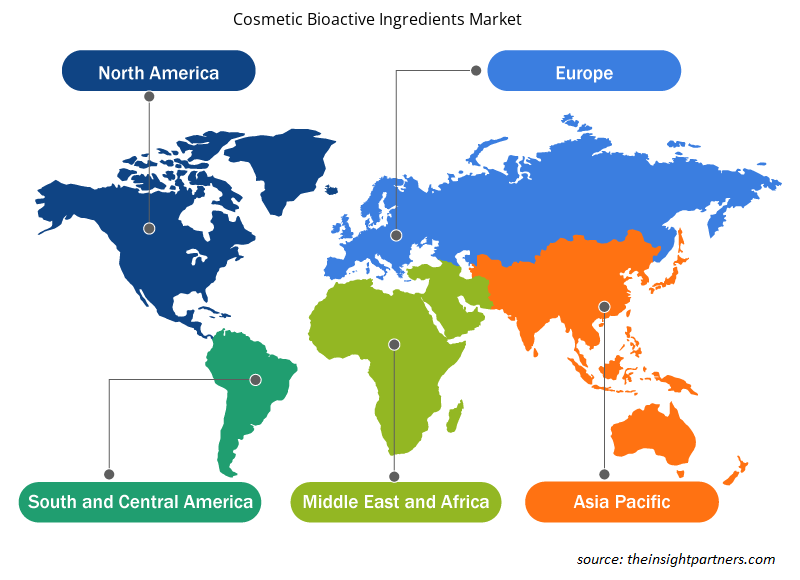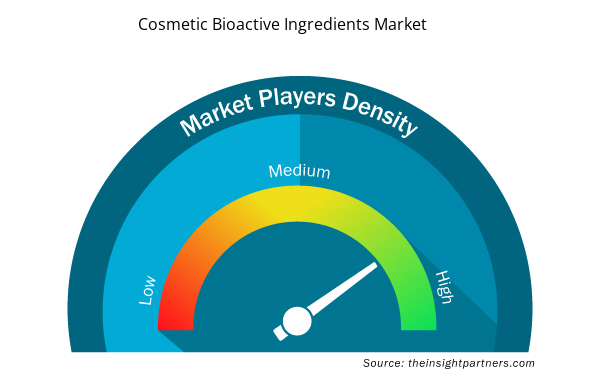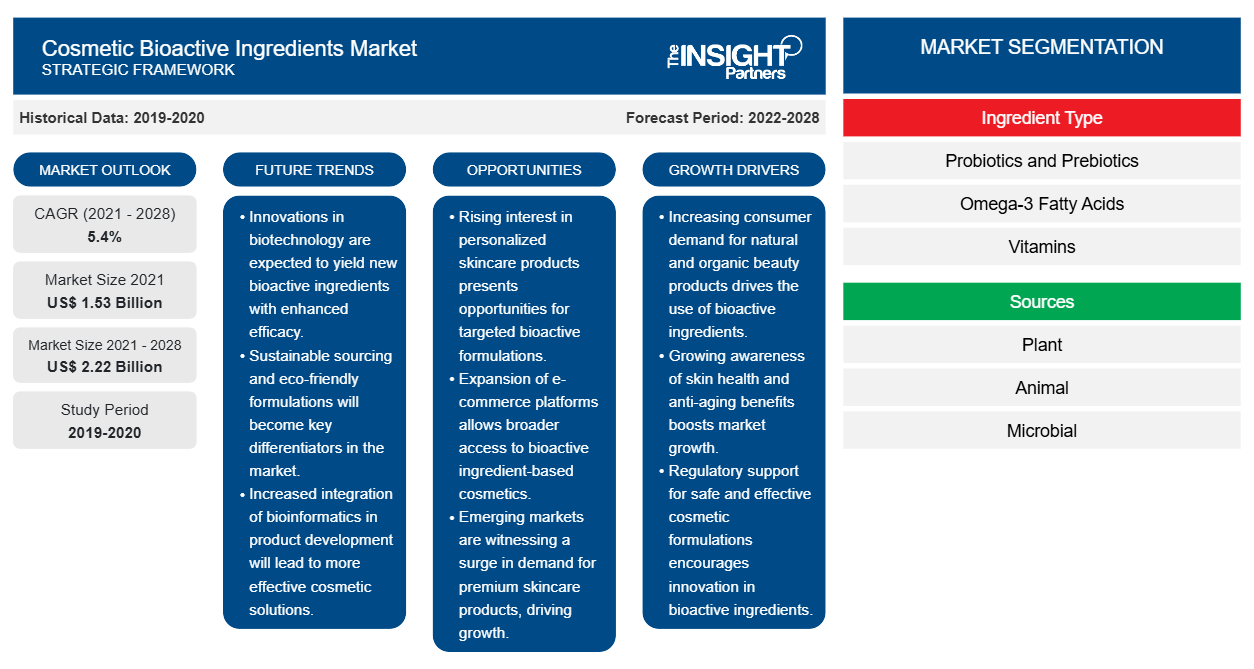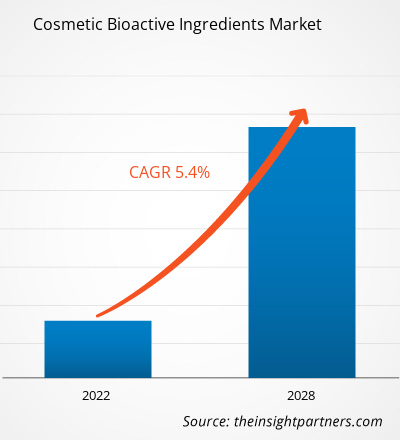Se proyecta que el mercado de ingredientes bioactivos cosméticos alcance los US$ 2.215,96 millones para 2028 desde los US$ 1.529,91 millones en 2021; se estima que crecerá a una CAGR del 5,4% entre 2021 y 2028.
Los cosméticos son productos elaborados para aplicar sobre la piel y el cabello con el fin de limpiar, embellecer, promover el atractivo o mejorar la apariencia. Entre los ingredientes activos que se suelen utilizar en este tipo de preparaciones, existe una tendencia mundial a incorporar productos de origen vegetal debido a su atractivo comercial, seguridad y rica composición, a menudo relacionada con un efecto sinérgico o multifuncional. Los extractos botánicos tienen un alto contenido de metabolitos secundarios que existen en plantas con una gran diversidad estructural. Tanto los flavonoides como los no flavonoides están relacionados con interesantes propiedades cosméticas como la fotoprotección, el antienvejecimiento, la hidratación, los antioxidantes, los astringentes, los antiirritantes y la actividad antimicrobiana. Con sus componentes bioactivos y acciones farmacológicas, se ha demostrado que estos ingredientes bioactivos proporcionan beneficios dermatológicos con posibles aplicaciones para el rejuvenecimiento de la piel, la fotoprotección, la cicatrización de heridas y más. El crecimiento del mercado de ingredientes bioactivos cosméticos se atribuye principalmente a la creciente preferencia por los ingredientes naturales en los productos cosméticos y al creciente número de ingredientes bioactivos que se lanzan al mercado. Sin embargo, los estrictos marcos regulatorios están restringiendo el crecimiento del mercado de ingredientes bioactivos cosméticos .
Personalice este informe según sus necesidades
Obtendrá personalización en cualquier informe, sin cargo, incluidas partes de este informe o análisis a nivel de país, paquete de datos de Excel, así como también grandes ofertas y descuentos para empresas emergentes y universidades.
- Obtenga las principales tendencias clave del mercado de este informe.Esta muestra GRATUITA incluirá análisis de datos, desde tendencias del mercado hasta estimaciones y pronósticos.
Perspectivas del mercado
La creciente demanda de productos naturales por parte de los consumidores está impulsando la investigación relacionada con las sustancias bioactivas que se pueden utilizar en los cosméticos. Europa alberga algunos de los mayores fabricantes de ingredientes bioactivos y marcas de cuidado personal, como BASF y DSM. El lanzamiento de ingredientes bioactivos para la industria del cuidado personal está impulsando el crecimiento del mercado. En junio de 2019, BASF Care Creations lanzó tres nuevos ingredientes activos para el mercado de la belleza, que utilizan árboles de rambután que proporcionan hidratación y rejuvenecimiento a la piel. De manera similar, en abril de 2019, Lonza lanzó el ingrediente bioactivo H2OBioEV, que es una combinación única de ingredientes de origen natural (polisacáridos de Aphanothece Sacrum y Galactoarabinan) con agua y glicerina. El ingrediente confiere propiedades hidratantes al reponer humectantes esenciales, lo que facilita un entorno óptimo para la formación y el mantenimiento de una fuerte barrera proteica epidérmica.
Información basada en el tipo de ingrediente
Según el tipo de ingrediente, el mercado de ingredientes bioactivos cosméticos se divide en probióticos y prebióticos, ácidos grasos omega-3, vitaminas, carotenoides y antioxidantes, extractos de plantas, minerales, aminoácidos, proteínas y péptidos, entre otros. Es probable que el segmento de aminoácidos tenga la mayor participación del mercado en 2021. Sin embargo, se prevé que el segmento de extractos de plantas registre la CAGR más alta del mercado durante el período de pronóstico.
Perspectivas basadas en fuentes
El mercado de ingredientes bioactivos cosméticos, por fuentes, se segmenta en vegetales, animales y microbianos. Es probable que el segmento vegetal tenga la mayor participación del mercado en 2021. Sin embargo, se prevé que el segmento microbiano registre la CAGR más alta del mercado durante el período de pronóstico.
Las empresas que operan en el mercado de ingredientes bioactivos cosméticos están adoptando estrategias como lanzamientos de productos, fusiones y adquisiciones, colaboraciones, innovaciones de productos y cartera de productos para expandir su presencia en todo el mundo, mantener la marca y satisfacer la creciente demanda de los usuarios finales.
Perspectivas regionales del mercado de ingredientes bioactivos cosméticos
Los analistas de Insight Partners explicaron en detalle las tendencias y los factores regionales que influyen en el mercado de ingredientes bioactivos cosméticos durante el período de pronóstico. Esta sección también analiza los segmentos y la geografía del mercado de ingredientes bioactivos cosméticos en América del Norte, Europa, Asia Pacífico, Oriente Medio y África, y América del Sur y Central.

- Obtenga datos regionales específicos para el mercado de ingredientes bioactivos cosméticos
Alcance del informe de mercado de ingredientes bioactivos cosméticos
| Atributo del informe | Detalles |
|---|---|
| Tamaño del mercado en 2021 | 1.530 millones de dólares estadounidenses |
| Tamaño del mercado en 2028 | US$ 2.22 mil millones |
| CAGR global (2021-2028) | 5,4% |
| Datos históricos | 2019-2020 |
| Período de pronóstico | 2022-2028 |
| Segmentos cubiertos | Por tipo de ingrediente
|
| Regiones y países cubiertos | América del norte
|
| Líderes del mercado y perfiles de empresas clave |
|
Densidad de actores del mercado de ingredientes bioactivos cosméticos: comprensión de su impacto en la dinámica empresarial
El mercado de ingredientes bioactivos cosméticos está creciendo rápidamente, impulsado por la creciente demanda de los usuarios finales debido a factores como la evolución de las preferencias de los consumidores, los avances tecnológicos y una mayor conciencia de los beneficios del producto. A medida que aumenta la demanda, las empresas amplían sus ofertas, innovan para satisfacer las necesidades de los consumidores y aprovechan las tendencias emergentes, lo que impulsa aún más el crecimiento del mercado.
La densidad de actores del mercado se refiere a la distribución de las empresas o firmas que operan dentro de un mercado o industria en particular. Indica cuántos competidores (actores del mercado) están presentes en un espacio de mercado determinado en relación con su tamaño o valor total de mercado.
Las principales empresas que operan en el mercado de ingredientes bioactivos cosméticos son:
- Koninklijke DSM NV
- Compañía Ajinomoto, Inc.
- Roquette Hermanos
- ADM
- BASF SE
Descargo de responsabilidad : Las empresas enumeradas anteriormente no están clasificadas en ningún orden particular.

- Obtenga una descripción general de los principales actores clave del mercado de ingredientes bioactivos cosméticos
Mercado de ingredientes bioactivos cosméticos – porTipo de ingrediente
- Probióticos y prebióticos
- Ácidos grasos omega-3
- Vitaminas
- Carotenoides y antioxidantes
- Extractos de plantas
- Minerales
- Aminoácidos
- Proteínas y péptidos
- Otros
Mercado de ingredientes bioactivos cosméticos: por fuente
- Planta
- Animal
- Microbiano
Mercado de ingredientes bioactivos cosméticos por geografía
América del norte
- A NOSOTROS
- Canadá
- México
Europa
- Francia
- Alemania
- Italia
- Reino Unido
- España
- Resto de Europa
Asia Pacífico (APAC)
- Porcelana
- India
- Corea del Sur
- Japón
- Australia
- Resto de Asia Pacífico
Oriente Medio y África (MEA)
- Sudáfrica
- Arabia Saudita
- Emiratos Árabes Unidos
- Resto de Oriente Medio y África
América del Sur (SAM)
- Brasil
- Argentina
- Resto de América del Sur y Central
Perfiles de empresas
- Koninklijke DSM NV
- Compañía Ajinomoto, Inc.
- Roquette Hermanos
- ADM
- BASF SE
- Corporación FMC
- Biotecnología Vytrus
- Compañía: Cargill Inc.
- Corporación de tecnologías sensibles
- Dupont
- Análisis histórico (2 años), año base, pronóstico (7 años) con CAGR
- Análisis PEST y FODA
- Tamaño del mercado Valor/volumen: global, regional, nacional
- Industria y panorama competitivo
- Conjunto de datos de Excel



Report Coverage
Revenue forecast, Company Analysis, Industry landscape, Growth factors, and Trends

Segment Covered
This text is related
to segments covered.

Regional Scope
North America, Europe, Asia Pacific, Middle East & Africa, South & Central America

Country Scope
This text is related
to country scope.
Preguntas frecuentes
Global cosmetic bioactive ingredients market is segmented by region into North America, Europe, Asia Pacific, Middle East & Africa, and South & Central America. In North America, the U.S. is the largest market for cosmetic bioactive ingredients. The growth of the region is attributed to increasing product launches coupled with increasing adoption of cosmetics.
The Europe region is expected to account for the fastest growth in the cosmetic bioactive ingredients market. Technological advancement for extraction of bioactive ingredients in this region contribute to this dominant share. Additionally, rising preference for natural ingredients in cosmetic products are said to be responsible for this growth.
The cosmetic bioactive ingredients market majorly consists of the players such BASF SE, DuPont de Nemours, Inc., FMC CORPORATION, Cargill, Incorporated, Sensient Technologies Corporation, DSM, Ajinomoto Co. Inc., Roquette Frères, ADM, and Vytrus Biotech amongst others.
The plant segment dominated the global cosmetic bioactive ingredients market and accounted for the largest revenue share of 62.50% in 2021.
The amino acids segment dominated the global cosmetic bioactive ingredients market and held the largest revenue share of 20.81% in 2021.
Key factors that are driving the growth of this market is rising preference for natural ingredients in cosmetic products and increasing launch of bioactive ingredients.
Cosmetics are products made to apply to the skin and hair to cleansing, beautifying, promoting attractiveness, or improving appearance. Amid the active ingredients usually used in this type of preparation, there is a global trend of incorporating vegetable source products due to their commercial appeal, safety, and rich composition, often related with a synergistic or multifunctional effect. Botanical extracts are high in secondary metabolites that exist in plants with high structural diversity. Both flavonoids and non-flavonoids are related to interesting cosmetic properties like photoprotection, anti-aging, moisturizing, antioxidant, astringent, anti-irritant, and antimicrobial activity. With their bioactive components and pharmacologic actions, these bioactive ingredients have been shown to provide dermatologic benefits with potential applications for skin rejuvenation, photoprotection, wound healing, and more.
Trends and growth analysis reports related to Chemicals and Materials : READ MORE..
The List of Companies - Cosmetic Bioactive Ingredients Market
- Koninklijke DSM N.V.
- Ajinomoto Co., Inc.
- Roquette Freres
- ADM
- BASF SE
- FMC Corporation
- Vytrus Biotech
- Cargill, Inc.
- Sensient Technologies Corporation
- DUPONT
The Insight Partners performs research in 4 major stages: Data Collection & Secondary Research, Primary Research, Data Analysis and Data Triangulation & Final Review.
- Data Collection and Secondary Research:
As a market research and consulting firm operating from a decade, we have published and advised several client across the globe. First step for any study will start with an assessment of currently available data and insights from existing reports. Further, historical and current market information is collected from Investor Presentations, Annual Reports, SEC Filings, etc., and other information related to company’s performance and market positioning are gathered from Paid Databases (Factiva, Hoovers, and Reuters) and various other publications available in public domain.
Several associations trade associates, technical forums, institutes, societies and organization are accessed to gain technical as well as market related insights through their publications such as research papers, blogs and press releases related to the studies are referred to get cues about the market. Further, white papers, journals, magazines, and other news articles published in last 3 years are scrutinized and analyzed to understand the current market trends.
- Primary Research:
The primarily interview analysis comprise of data obtained from industry participants interview and answers to survey questions gathered by in-house primary team.
For primary research, interviews are conducted with industry experts/CEOs/Marketing Managers/VPs/Subject Matter Experts from both demand and supply side to get a 360-degree view of the market. The primary team conducts several interviews based on the complexity of the markets to understand the various market trends and dynamics which makes research more credible and precise.
A typical research interview fulfils the following functions:
- Provides first-hand information on the market size, market trends, growth trends, competitive landscape, and outlook
- Validates and strengthens in-house secondary research findings
- Develops the analysis team’s expertise and market understanding
Primary research involves email interactions and telephone interviews for each market, category, segment, and sub-segment across geographies. The participants who typically take part in such a process include, but are not limited to:
- Industry participants: VPs, business development managers, market intelligence managers and national sales managers
- Outside experts: Valuation experts, research analysts and key opinion leaders specializing in the electronics and semiconductor industry.
Below is the breakup of our primary respondents by company, designation, and region:

Once we receive the confirmation from primary research sources or primary respondents, we finalize the base year market estimation and forecast the data as per the macroeconomic and microeconomic factors assessed during data collection.
- Data Analysis:
Once data is validated through both secondary as well as primary respondents, we finalize the market estimations by hypothesis formulation and factor analysis at regional and country level.
- Macro-Economic Factor Analysis:
We analyse macroeconomic indicators such the gross domestic product (GDP), increase in the demand for goods and services across industries, technological advancement, regional economic growth, governmental policies, the influence of COVID-19, PEST analysis, and other aspects. This analysis aids in setting benchmarks for various nations/regions and approximating market splits. Additionally, the general trend of the aforementioned components aid in determining the market's development possibilities.
- Country Level Data:
Various factors that are especially aligned to the country are taken into account to determine the market size for a certain area and country, including the presence of vendors, such as headquarters and offices, the country's GDP, demand patterns, and industry growth. To comprehend the market dynamics for the nation, a number of growth variables, inhibitors, application areas, and current market trends are researched. The aforementioned elements aid in determining the country's overall market's growth potential.
- Company Profile:
The “Table of Contents” is formulated by listing and analyzing more than 25 - 30 companies operating in the market ecosystem across geographies. However, we profile only 10 companies as a standard practice in our syndicate reports. These 10 companies comprise leading, emerging, and regional players. Nonetheless, our analysis is not restricted to the 10 listed companies, we also analyze other companies present in the market to develop a holistic view and understand the prevailing trends. The “Company Profiles” section in the report covers key facts, business description, products & services, financial information, SWOT analysis, and key developments. The financial information presented is extracted from the annual reports and official documents of the publicly listed companies. Upon collecting the information for the sections of respective companies, we verify them via various primary sources and then compile the data in respective company profiles. The company level information helps us in deriving the base number as well as in forecasting the market size.
- Developing Base Number:
Aggregation of sales statistics (2020-2022) and macro-economic factor, and other secondary and primary research insights are utilized to arrive at base number and related market shares for 2022. The data gaps are identified in this step and relevant market data is analyzed, collected from paid primary interviews or databases. On finalizing the base year market size, forecasts are developed on the basis of macro-economic, industry and market growth factors and company level analysis.
- Data Triangulation and Final Review:
The market findings and base year market size calculations are validated from supply as well as demand side. Demand side validations are based on macro-economic factor analysis and benchmarks for respective regions and countries. In case of supply side validations, revenues of major companies are estimated (in case not available) based on industry benchmark, approximate number of employees, product portfolio, and primary interviews revenues are gathered. Further revenue from target product/service segment is assessed to avoid overshooting of market statistics. In case of heavy deviations between supply and demand side values, all thes steps are repeated to achieve synchronization.
We follow an iterative model, wherein we share our research findings with Subject Matter Experts (SME’s) and Key Opinion Leaders (KOLs) until consensus view of the market is not formulated – this model negates any drastic deviation in the opinions of experts. Only validated and universally acceptable research findings are quoted in our reports.
We have important check points that we use to validate our research findings – which we call – data triangulation, where we validate the information, we generate from secondary sources with primary interviews and then we re-validate with our internal data bases and Subject matter experts. This comprehensive model enables us to deliver high quality, reliable data in shortest possible time.


 Obtenga una muestra gratuita de este informe
Obtenga una muestra gratuita de este informe